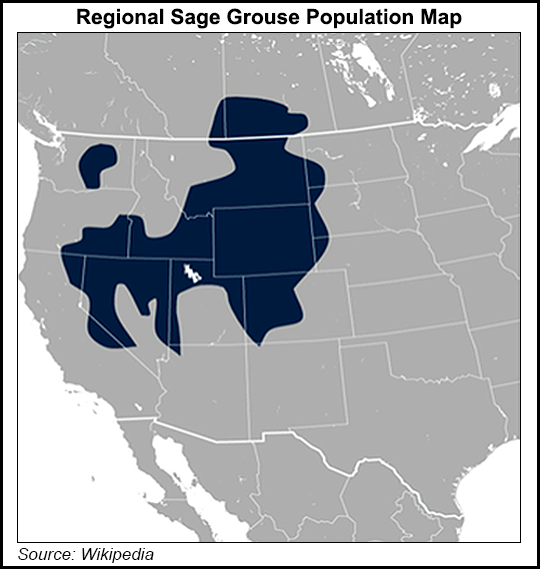Regulatory | NGI All News Access
Sage Grouse Plans Dissected Along Partisan Lines in Senate Hearing
Whether the omnibus bipartisan agreement between the Obama administration and many western state governors for protecting sage grouse habitat is effective and working seems split along partisan lines, based on testimony to a Senate Energy and Natural Resources Subcommittee hearing Tuesday.

Subcommittee Chair John Barrasso (R-WY) and witnesses sponsored by the Republican majority were highly critical of the Obama administration’s effort over the past nine months to implement the plan, which impacts the energy industry (see Shale Daily, Sept. 22, 2015). In contrast, Obama administration officials and witnesses supported by Democrats, including ranking minority member Sen. Ron Wyden (D-OR), said the collaborative state-federal effort to protect habitat is working.
Noting that implementation of the extensive, state-based plans “is no closer to completion now than it was nine months ago,” Barrasso said. At best, “the Obama administration plans were designed to justify keeping the greater sage grouse off the Endangered Species Act (ESA) listing, and at worse are part of a larger campaign to further restrict access to public land.”
Barrasso said delays in implementing the plans at the state level by the federal agencies is unacceptable now and will continue to be unacceptable in the future.
Industry and state groups have challenged the collaborative plans in court (see Daily GPI, May 13and Shale Daily, March 4). However, Wyoming Gov. Matt Mead is supporting the federal action (see Daily GPI, March 11).
The federal decision not to list the sage grouse under the ESA is “an important victory,” Wyden said. In eastern Oregon “a lot is being done to implement habitat restoration.” The U.S. Forest Service (USFS) decision not to list the bird “was a victory for all westerners.” The updated land-use plans by the USFS and Bureau of Land Management (BLM) were built on collaborative talks only a few days ago in eastern Oregon.
However, Sen. James Risch (R-ID) blasted what he called “the abysmal handling” of the sage grouse issue by the federal government. The former Idaho governor echoed several colleagues that charged the Department of Interior (DOI) agencies have ignored input from the states.
“I’m frankly disgusted with the way the federal government has gone about this, and I am very disenchanted with the Department of the Interior’s efforts, which I think have frustrated the states’ efforts that are good-faith, solid efforts to try to do what needs to be done for these birds.”
Risch later softened his criticism and said all sides agree with the overall goal of protecting the birds and their habitat while allowing responsible development on federal lands.
Utah’s director of state-federal coordination Kathleen Clarke said the state has spent $50 million in research and planning for sage grouse protections since 2006. Since 2013 the state-private sector efforts have resulted in a 50% growth in the population. Despite the state’s success, however, suggestions to federal agencies so far have been ignored, according to subcommittee member Sen. Mike Lee (R-UT).
DOI Deputy Assistant Secretary for Lands and Minerals Jim Lyons, and USFS Director Robert Harper of the Department of Agriculture emphasized the collaborative effort with states is ongoing. Harper said “remarkable science” was being applied to the effort.
But Clarke and others pointed to examples of “top-down, one-size-fits-all” federal rules and programs being forced on the states.
Meanwhile, National Mining Association’s Katie Sweeney said the group’s mining plans in the affected western states impact less than 1% of about 10 million acres overall involving the sage grouse protection area, yet all the acreage has been designated as off limits for mining.
“How can a 10 million-acre withdrawal be justified by an activity with this small of an existing footprint?” Sweeney asked the subcommittee.
By comparison, Sweeney said last year a single major wildfire wiped out 200,000 acres of sage grouse habitat. “Mining activities are not a major threat to the sage grouse,” she said.
© 2024 Natural Gas Intelligence. All rights reserved.
ISSN © 1532-1231 | ISSN © 2577-9877 |
